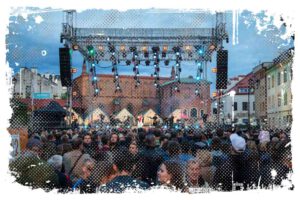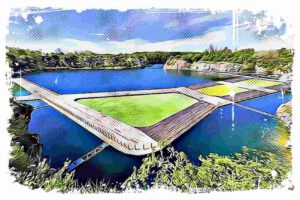I will put it this way – you can experience the Planty Park in Kraków in a myriad of ways. Even a short stroll or just a moment on one of its many benches can provide a breath of fresh air, relaxation, and the joy of being close to nature. However, if you need a longer walk, why not bring the whole family along? Trust me, the shared time spent here will fuel the kids with an abundance of emotions.
Being there, you need to know, Planty Krakowskie is not regular park but a place to explore nature, admire rare tree species, and seek hidden monuments among the greenery. When autumn comes, you can even collect chestnuts and colorful leaves. I think, it’s worth to say, it also offers the chance to play detective and find remnants of ancient defensive walls.

Let me tell you now, it’s the only urban park in Poland that encapsulates the entire Old Town. Crossing its line takes you to the suburbs of the medieval town, and if you head the opposite way, you step into the historical center.
Planty – The Heart and Soul of Kraków’s Parks
What makes Planty Krakowskie the most „Kraków-ish” of all city parks? I am convinced it’s the equal blend of nature and culture that breathe life into this park. Here, you will find exceptional historical, cultural, and natural values protected and preserved.
↳ Make sure to read my guide to the most amazing places to stay in Kraków:
How to Find Best Place to Stay in Krakow Old Town – Your Guide

Born in the 1820s on the site of Kraków’s demolished defensive walls, this unique park owes its shape to its location. After filling the moat and 'planting’ – leveling the ground (hence today’s name Planty), an urban garden was created. I can tell you that this green ring, which measures over 4km, delineates the city’s boundaries.
What Can You See During Your Walk?
From the north, a fragment of old fortifications still exists today – a 200-meter wall, the adjacent Ciesielska, Pasamoników, Stolarska towers, Kuśnierzy tower with Floriańska Gate, Barbakan, and the remodeled City Arsenal.
Walking westwards, you can spot a monument dedicated to the memory of poet Bohdan Zaleski next to a pond. It features Bojan the Lyricist with a youth, to whom the bearded musician is passing on a song – a treasure chest of national memory. This monument references the romantic poetry of Zaleski, who was called „the modern Bojan of Ukraine.”
Crossing Sławkowska Street, you’ll reach a small hill home to a monument of the royal couple – Jadwiga and Jagiełło. It was established here to commemorate the anniversary of the Union in Krewo (1385). The author, Oskar Sosnowski, modeled the work on the monument of Dobrawa of Bohemia and her husband Mieszko I.
Further on, near the Reformat Church, was the location of the medieval rurmus, the main building of the then water supply, set above the artificial riverbed of the Rudawa. From here, water was led by wooden pipes to smaller tanks in the city, known as rzápias.
Let me say that as you move forward along the Planty, just opposiet the Art Palace, you’ll spot a thought-provoking sculpture. It features a contemplative Artur Grottger, an artist who immortalized the January Uprising. Polish artists raised funds to honor his memory with this masterpiece.

As you continue your journey, I think it is worth saying, take a pause at the buildings of Uniwersytet Jagielloński. There, amongst the trees in front of Collegium Witkowskiego, you can find a monument dedicated to Nicolaus Copernicus, a great astronomer who studied at this university.
Right across from it, you’ll see the Dąb Wolności, an oak tree planted in 1919 to commemorate Poland’s regained independence. This spot holds extra significance because, in 2000, soil from Sachsenhausen, Dachau, and Katyn was added – sites where university professors and students perished during World War II.
Near the base of Wawel hill, you’ll notice the building of the Wyższe Seminarium Duchowne. Here, they remember one of their most famous students and professors, Karol Wojtyła, better known as Pope John Paul II.
Beside it, clerics and a multitude of secular students study at the Papieska Akademia Teologiczna (now Uniwersytet Papieski Jana Pawła II), established in 1981 by the Polish Pope, continuing the tradition of the Theology Department of UJ.
The Reputation of the Planty
This segment of the Planty, from the site of the former rurmus to Wawel hill, always held a good reputation, bolstered by the nearby buildings of the Art Palace, St. Anne’s Church, and the University.
The areas near the train station, however, weren’t always so lucky. But that’s all in the past now. Today, you can find a noteworthy obelisk there, dedicated to Florian Straszewski, co-creator of the park, and the Juliusz Słowacki Theater, located on the site of the former monastery and church of the Duchaków.

I think it’s worth to say, the visionaries of the Planty imagined it as a family oasis, a place for strolls, friendly meetings, and most of all, children’s play. I am convinced that the Planty Krakowskie successfully fulfills this role to this day.
Where Did the Planty Krakowskie Originate?
The first written mentions of Krakow’s defensive system date back to the rule of Prince Leszek Czarny. In the 15th century, a barbakan was added to the city walls, an exemplary foregate, and the most spectacular element of the city’s defensive architecture.
Unfortunately, between 1810 and 1814, the city walls were demolished. The Senate of the Free City of Krakow then decided to turn the former fortification grounds into a city park – the Planty.
The park’s name comes from a process called ’plantowanie’ – which mean leveling the land surrounding the city walls and filling in the moats.
The destruction of the city walls not only led to the creation of the park but also the construction of a ring road and new city exits. The Planty covers over 20 hectares and has a circumference of about 4 km.
Strolling further, Planty Krakowskie often takes its visitors by surprise, thanks to the not-so-known tales associated with the place. Krakow’s Lottery, a spectacle, held at the Hetmańska building.
It was nothing less than a town fair. Every Wednesday, a special drum, filled with a hundred numbered balls, spun, choosing five. Those five lucky numbers, dropped into special holes in the huge wooden coat of arms of Krakow, mounted on the building’s facade. I think it’s worth saying that the lottery sparked immense excitement within Krakow’s close-knit community.

When Krakow’s Lottery Stirred Emotion
Ambroży Grabowski, the city’s first scholar, had a lot to say about Straszewski, the lottery’s orchestrator. He pointed out how the locals, primarily the lower classes – workers and servants – were gambling away their earnings, leaving their pockets empty.
But, ironically, the income from the lottery was being used by Straszewski to develop Planty Krakowskie. It makes you wonder – who contributred more to the park’s development, Straszewski or the lottery-playing locals?
When did the Planty come into Existence?
The exact date when Planty Krakowskie was established is also debated. Although most sources claim 1820, apparently, the groundwork started earlier. What does „establishment year” really mean?
The decision date? Planting the first tree? Or the last? It wasn’t just about laying down a ready-made lawn, like on a football field. Projects like these unfold over several years. But, bit by bit, the park emerged from what was once a soggy pile of rubble.
How Planty was Initially Adorned
It might surprise you to know that in its initial years, Planty Krakowskie had virtually no trees. It would have looked more like a young grove! The underlying ground was filled with tons of bricks and stones from the demolished walls, making the growth of trees difficult. Additional soil had to be added to support the plant life.
The park’s decoration relied heavily on scattered large stone balls, similar to those excavated from Wawel’s underground. There was even room for a small mound. Originally, the barriers and lanterns were painted city blue. Park-goers sat on stone benches, and water for the greenery was transported in tank wagons pulled by… donkeys.
I can tell that these humble beginnings of Planty Krakowskie are indeed fascinating, painting a unique image of the park in its early years. Imagine that – a place known for its lush greenery was once a modest grove with stone balls for decoration. A bit different from what you see today, isn’t it?
What was Forbidden in Planty in the 19th Century?
Did you know that as early as 1834, it was strictly prohibited to graze cattle in Planty Krakowskie? But they didn’t stop there. Over time, even more upsetting restrictions were introduced.
After 1856, horse-riding was a big no-no, which was loudly proclaimed on signboards throughout the park. Much later, even collecting chestnuts was forbidden! A private company had managed to secure the right to gather these. They put them to good use, manufacturing popular and valued toys.
The Pride of the Locals

Despite these inconveniences, Krakow residents held a great sense of pride for Planty Krakowskie. Believe it or not, before the park, there wasn’t a single place in town where one could take a greenery-filled stroll or simply sit on a bench.
Planty Krakowskie was a breath of fresh air – it was a total game-changer! And I can tell, it is one of the most successful investments in Krakow’s history. If you need a relaxing spot in the city, Planty Krakowskie is definitely a place to consider. Even with all its rules, this park holds a special place in the hearts of the locals. And I am convinced, it will charm you too.
References:
- https://www.gpsmycity.com/attractions/planty-park-18065.html
- https://en.wikipedia.org/wiki/Planty_Park_(Krak%C3%B3w)




